The banjo is a stringed instrument with a thin membrane stretched over a frame or cavity to form a resonator. The membrane is typically circular, in modern forms usually made of plastic, originally of animal skin. Early forms of the instrument were fashioned by African Americans and had African antecedents. In the 19th century, interest in the instrument was spread across the United States and United Kingdom by traveling shows of the 19th century minstrel show fad, followed by mass-production and mail-order sales, including instruction method books. The inexpensive or home-made banjo remained part of rural folk culture, but 5-string and 4-string banjos also became popular for home parlor music entertainment, college music clubs, and early 20th century jazz bands. By the early 21st century, the banjo was most frequently associated with folk, bluegrass and country music, but was also used in some rock, pop and even hip-hop music. Among rock bands, the Eagles, Led Zeppelin, and the Grateful Dead have used the five-string banjo in some of their songs. Some famous pickers of the banjo are Ralph Stanley and Earl Scruggs.

The classical guitar, also called modern classical guitar, is a member of the guitar family used in classical music and other styles. An acoustic wooden string instrument with strings made of gut or nylon, it is a precursor of the modern steel-string acoustic and electric guitars, both of which use metal strings. Classical guitars derive from instruments suh as the lute, the vihuela, the gittern, which evolved into the Renaissance guitar and into the 17th and 18th-century baroque guitar. By the mid-19th century, early forms of the modern classical guitar appear. Today's modern classical guitar was established by the late designs of the 19th-century Spanish luthier, Antonio Torres Jurado.

The guitar is a stringed musical instrument that is usually fretted and typically has six or twelve strings. It is usually held flat against the player's body and played by strumming or plucking the strings with the dominant hand, while simultaneously pressing selected strings against frets with the fingers of the opposite hand. A guitar pick may also be used to strike the strings. The sound of the guitar is projected either acoustically, by means of a resonant hollow chamber on the guitar, or amplified by an electronic pickup and an amplifier.

Zithers are a class of stringed instruments. Historically, it could be any instrument of the psaltery family. In modern terminology, it is more specifically an instrument consisting of many strings stretched across a thin, flat body, the topic of this article.

Slapping and popping are ways to produce percussive sounds on a stringed instrument. They are primarily used on the double bass or bass guitar. Slapping on bass guitar involves using the edge of one's knuckle, where it is particularly bony, to quickly strike the string against the fretboard. On bass guitars, this is commonly done with the thumb, while on double bass, the edge of the hand or index finger may be used. Popping refers to pulling the string away from the fretboard and quickly releasing it so it snaps back against the fretboard. On bass guitar, the two techniques are commonly used together in alternation, though either may be used separately.

Clawhammer, sometimes called down-picking, overhand, or frailing, is a distinctive banjo playing style and a common component of American old-time music.

A twelve-string guitar is a steel-string guitar with 12 strings in six courses, which produces a thicker, more ringing tone than a standard six-string guitar. Typically, the strings of the lower four courses are tuned in octaves, with those of the upper two courses tuned in unison. The gap between the strings within each dual-string course is narrow, and the strings of each course are fretted and plucked as a single unit. The neck is wider, to accommodate the extra strings, and is similar to the width of a classical guitar neck. The sound, particularly on acoustic instruments, is fuller and more harmonically resonant than six-string instruments. The 12-string guitar can be played like a 6-string guitar as players still use the same notes, chords and guitar techniques like a standard 6-string guitar, but advanced techniques might be tough as players need to play or pluck two strings simultaneously.
Lead guitar is a musical part for a guitar in which the guitarist plays melody lines, instrumental fill passages, guitar solos, and occasionally, some riffs and chords within a song structure. The lead is the featured guitar, which usually plays single-note-based lines or double-stops. In rock, heavy metal, blues, jazz, punk, fusion, some pop, and other music styles, lead guitar lines are often supported by a second guitarist who plays rhythm guitar, which consists of accompaniment chords and riffs.

The Appalachian dulcimer is a fretted string instrument of the zither family, typically with three or four strings, originally played in the Appalachian region of the United States. The body extends the length of the fingerboard, and its fretting is generally diatonic.

A fingerpick is a type of plectrum used most commonly for playing bluegrass style banjo music. Most fingerpicks are composed of metal or plastic. Unlike flat guitar picks, which are held between the thumb and finger and used one at a time, fingerpicks clip onto or wrap around the end of the fingers and thumb; thus one hand can pick several strings at once. Generally four are used: one for the thumb, and one each for the ring, middle and index fingers. Fingerpicks worn on the thumb are generally called "thumbpicks". Some players use a plastic thumbpick while using metal fingerpicks. Fingerpicks come in a variety of thicknesses to accommodate different musicians' styles of playing. Thin picks produce a quieter, more delicate sound, while thick picks produce a heavier sound. But as with standard plectrums, thumbpicks come in different styles and employ different materials.

In music, strumming is a way of playing a stringed instrument such as a guitar, ukulele, or mandolin. A strum or stroke is a sweeping action where a finger or plectrum brushes over several strings to generate sound. On most stringed instruments, strums are typically executed by a musician's designated strum hand, while the remaining hand often supports the strum hand by altering the tones and pitches of any given strum.
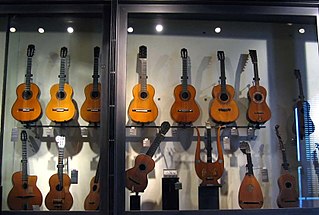
The following outline is provided as an overview of and topical guide to guitars:
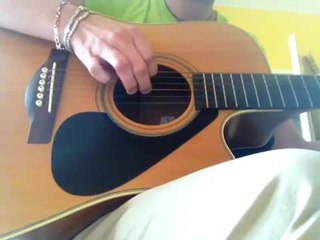
Hybrid picking is a guitar-playing technique that involves picking with a pick (plectrum) and one or more fingers alternately or simultaneously. Hybrid picking allows guitar players who use a pick to perform music which would normally require fingerstyle playing. It also facilitates wide string leaps which might otherwise be quite difficult. The technique is not widespread in most genres of guitar playing, but is most often employed in "chicken pickin'"; rockabilly, country, honky-tonk, and bluegrass flatpicking styles who play music which occasionally demands fingerstyle passages.
Hybrid picking involves playing with the pick and the right hand m and/or a fingers...at the same time. The pick is held in the usual way...and the fingers execute free strokes in the typical fingerstyle manner...Hybrid picking allows fingerstyle-like passages to be freely interspersed with flatpicked passages...without any delay.
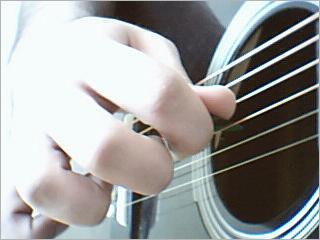
Flatpicking is the technique of striking the strings of a guitar with a pick held between the thumb and one or two fingers. It can be contrasted to fingerstyle guitar, which is playing with individual fingers, with or without wearing fingerpicks. While the use of a plectrum is common in many musical traditions, the exact term "flatpicking" is most commonly associated with Appalachian music of the American southeastern highlands, especially bluegrass music, where string bands often feature musicians playing a variety of styles, both fingerpicking and flatpicking. Musicians who use a flat pick in other genres such as rock and jazz are not commonly described as flatpickers or even plectrum guitarists. As the use of a pick in those traditions is commonplace, generally only guitarists who play without a pick are noted by the term "fingerpicking" or "fingerstyle".
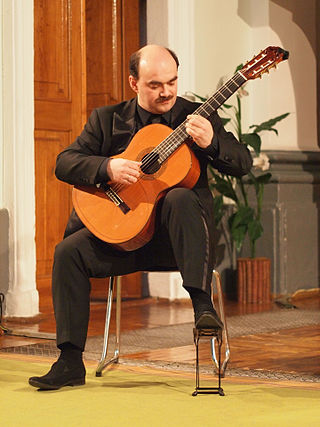
In classical guitar, the right hand is developed in such a way that it can sustain two, three, and four voice harmonies while also paying special attention to tone production. The index (i), middle (m), and ring (a) fingers are generally used to play the melody, while the thumb (p) accompanies in the bass register adding harmony and produces a comparable texture and effect to that of the piano. The classical guitar is a solo polyphonic instrument, and it is difficult to master.

A flamenco guitar is a guitar similar to a classical guitar, but with thinner tops and less internal bracing. It usually has nylon strings, like the classical guitar, but it generally possesses a livelier, more gritty sound compared to the classical guitar. It is used in toque, the guitar-playing part of the art of flamenco.
An acoustic guitar is a musical instrument in the string family. When a string is plucked, its vibration is transmitted from the bridge, resonating throughout the top of the guitar. It is also transmitted to the side and back of the instrument, resonating through the air in the body, and producing sound from the sound hole. While the original, general term for this stringed instrument is guitar, the retronym 'acoustic guitar' – often used to indicate the steel stringed model – distinguishes it from an electric guitar, which relies on electronic amplification. Typically, a guitar's body is a sound box, of which the top side serves as a sound board that enhances the vibration sounds of the strings. In standard tuning the guitar's six strings are tuned (low to high) E2 A2 D3 G3 B3 E4.
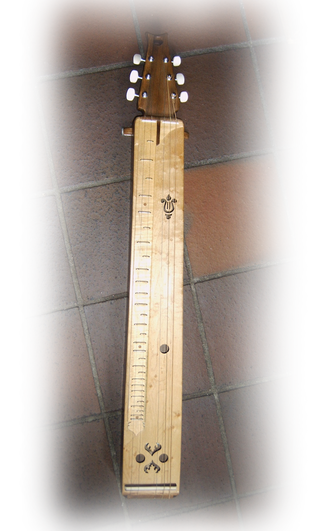
The épinette des Vosges is a traditional plucked-string instrument of the zither family, whose use was confined to two areas in the Vosges mountains of France approximately 50 km apart: around Val-d'Ajol and around Gérardmer.

Carter Family picking, also known as the thumb brush, the Carter lick, the church lick, or the Carter scratch, is a style of fingerstyle guitar named after Maybelle Carter of the Carter Family. It is a distinctive style of rhythm guitar in which the melody is played on the bass strings, usually low E, A, and D while rhythm strumming continues above, on the treble strings, G, B, and high E. This often occurs during the break. The style bears similarity to the frailing style of banjo playing and is the rhythm Bill Monroe adapted for bluegrass music two decades later.

Guitar picking is a group of hand and finger techniques a guitarist uses to set guitar strings in motion to produce audible notes. These techniques involve plucking, strumming, brushing, etc. Picking can be done with:





































